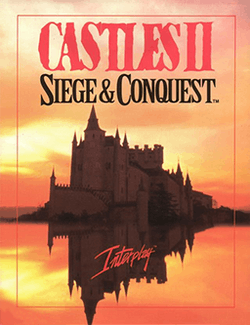Castles II: Siege and Conquest
| Castles II: Siege and Conquest | |
|---|---|
 Cover art | |
| Developer(s) | Quicksilver Software |
| Publisher(s) | Interplay Entertainment |
| Platform(s) | Macintosh DOS Amiga CD32 (Amiga floppy disk version unreleased[1]) |
| Release date(s) | Mac OS
|
| Genre(s) | Strategy |
| Mode(s) | Single-player |
| Distribution | Floppy disk, CD-ROM |
Castles II: Siege and Conquest is a strategy video game developed for the Macintosh, Amiga and DOS by Interplay Entertainment in 1992, designed and developed by Quicksilver Software; the Macintosh version of the game was published by Interplay Entertainment under the MacPlay brand name. Castles II is the sequel to the 1991 game Castles.
Story
The player takes the role of one of five different nobles (Albion, Duke of Valois, Anjou, Aragon, or Burgundy), fighting for the title of King of Bretagne. In addition, three territories are controlled by the Pope.
Gameplay
Gameplay includes scouting out unknown territories, conquering them, building castles to prevent revolts and line defenses, raising an army, feeding and paying them, and eventually making a claim for the title of King. Depending on how strong the human player or the other four AI-engined nobles are, the Pope will decide whether or not to endorse the claim. Therefore, attacking someone that claims the title can prevent them from getting it. Using diplomacy also allows the player to maintain high relationships with the other nobles and with the Pope, a useful feature to protect from attack. Alternately, the player can conquer everyone and even the Pope to win by default (in which case the anti-Pope will also endorse the player's claim to the throne).
Depending on which noble is picked, the player can start at any of five general areas of the map. Initially he is provided with one territory rich in one of four resources: gold, timber, iron, or food. Having more of one kind of resource territory increases the total amount that the player can harvest per turn (also dependent on the total amount of "points" allocated). Players can only gather the resources in territories they control, so a player who does not control at least one of each kind must rely on trades to gain those resources.
At first the player can perform one task each of three types at once: administrative (gathering resources and building castles, represented by a green bar), military (recruiting an army, building optional weapons like a catapult, and policing the realm, represented in red), and political (sending scouts, diplomats, and spies, represented in blue). The more a type of task is performed, the more points which may be devoted to that kind of task are gained (to a limit of 9 per type). At a rating of 5, two tasks can be performed at once.
The most remarkable feature at the time for Castles II: Siege and Conquest was the ability to design and save different castles. Depending on the total number of walls and turrets, the castles were assigned point values that determined how long it takes to build. Larger castles are harder to destroy or capture, which serves to keep enemies out of the controlled lands. Large castles are also used to prevent revolts. Armies include infantry, archers, and knights, each costing a different resource to recruit. The size of the army that can be raised is dependent upon the number of territories and castles the player possess.
PC CD-ROM version
A CD-ROM version of the game features an extensive amount of full motion video about the history and purpose of different castles around Europe, presented by a historian as short informative clips that were separate from the game. The CD version also featured a full orchestral soundtrack by composer Charles Deenen. Also present are video scenes taken from The Private Life of Henry VIII and Alexander Nevsky that play during certain events that occur throughout the game.[2]
Copy Protection
Once in a while, a question will be given to the player to "determine if he is the real king". The answer to this question can only be found in the manual, done as a form of copy protection. A wrong answer will result in a game over screen.
Reception
Computer Gaming World in 1993 called Castles II "a first-rate strategy game ... a joy to play", praising the user interface, variety of play options, and strong computer AI.[3] In a 1993 survey of pre 20th-century strategy games the magazine gave the game three-plus stars out of five, calling it "Much more of a wargame than the former, and worthy of examination by anyone interested in the period".[4] The game received 4 out of 5 stars in Dragon.[5]
See also
References
- ↑ "Amiga version is unreleased". IGN. Retrieved 2007-07-28.
- ↑ "MobyGames credits". Retrieved 2013-02-28.
- ↑ Hill, Ken (1993-04). "Interplay's Castles II". Computer Gaming World. p. 100. Retrieved 6 July 2014. Check date values in:
|date=(help) - ↑ Brooks, M. Evan (1993-06). "An Annotated Listing of Pre-20th Century Wargames". Computer Gaming World. p. 136. Retrieved 7 July 2014. Check date values in:
|date=(help) - ↑ Lesser, Hartley; Lesser, Patricia & Lesser, Kirk (May 1993). "The Role of Computers". Dragon (193): 57–63.
- ATPM, Review: Castles—Siege & Conquest, by Tom Beadling